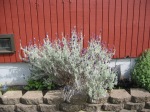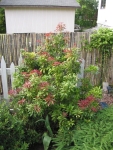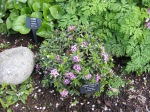- Coming Down to the Cabins
- Barker Mountain in the Distance
- Sacred Mountain
- Looking Down into the Bowl
- Drive and View to the South
- Sage Patch at Top
- Tonasket in the Distance
- Kettle Range and Aeneas Valley
- Looking Down to the Pond
- Louie in Lupin
- Looking North to Canada
- Moon Rock in Back
- Cabins in the Bowl
- More Cabins
- My Cabin
- The Kitchen
- Towards the Bedroom with Stove
- The Outhouse
- Cedar’s Cabin
- The First Cabin
- First Cabin
- View From the Deck
- Bristlecone Pine Planted in ’87
- Looking Towards the Pond
- The Pond as Wetland
- View Towards Back of Pond
- View Out of Pond
- Bear Scat
- Cougar Scat
- Ant Nest
I’m a lucky guy to have 2 gardens to be involved with. These pictures are of my 40 acre Homestead that I purchased with my friend Cedar 30 years ago this year. We lived there for several years, building cabins and trying to make a home on a piece of land where no one had ever lived before. It’s completely off the grid, with no electricity, running water, or phone, and we have a great outhouse too. It’s 1.75 miles just to drive up the driveway from the main county road and the last 1/2 mile is 4 wheel drive only because it’s so steep.
It’s a huge amount of land and I had great visions of creating my botanical garden there when we moved there in 1984. Unfortunately the pond we thought would give us water for years went down to a mud puddle by September and the work I did was so hard on me that my back eventually went into a bad spasm and I had to move back to the city in the fall of 1989. That 5 1/2 year period living there was quite wonderful and so exciting, but also so very hard on my body and spirit as I realized that I could never create the homestead and garden I’d envisioned there and had to give up those dreams in favor of just keeping the land as a retreat for ourselves and our friends.
I feel very grateful to “own” this land, tho our plan all along has been to entrust it to a Land Conservation Trust at some point when we can no longer manage to make it there and take care of the place. It’s a 7 hour drive from Seattle so we don’t go often but when we do we try to do the maintenance work that has to occur to keep it from being overtaken by the wild nature of the land. We have black bear, cougar, coyote, mule deer, pheasant, grouse, bobcat, lynx, eagles and hawks, and so many birds you can’t even keep track. The forest covers 1/2 of the land with a mix of Douglas Fir and Ponderosa Pine with some Quaking Aspen thrown in here and there for their beauty. The rest is Sagebrush and Bitterbrush Chaparral, or High Desert Plateau.
We tried planting some things there but only a few survived due to lack of regular water. One is the Bristlecone Pine in one picture we planted as part of a ceremony in 1987. It’s grown some with no water, but the native trees on the land have grown immensely in the 30 years we’ve had the land and it’s a Sanctuary for the plants and animals that live there. We plan to put restrictions in the Conservation Easement when we sell it so that it can never be logged or mined so this small 40 acre parcel will always be that Sanctuary in a very real sense. The land is wild and surrounded by other wild land, so it’s isolated at the end of the road and no one ever comes there but us.
It’s a safe haven for the animals except during deer season when hunters cross our No Trespassing signs and come to shoot our deer. Not much we can do but when we’re there we discourage it and I’ve had some run ins with hunters that were pretty scary to me, who doesn’t own a gun and never has and I confronted guys with rifles on occasion to get rid of them and not let them hunt there. It’s a challenge at times, but it’s been a hunting ground for some of the locals for years and they consider it their right to hunt there. It’s an attitude that we can’t change but can try to discourage, and we do.
The pictures are somewhat self explanatory with the labels I put on them, I hope. When I say we’re looking down into the Bowl, that’s the part in the center of the land that is surrounded on all sides by larger hills and is where the pond and all our cabins are located. It’s a 5 acre area that is about all the area we’ve done work on , and we’ve kept that to a minimum. We cleared out lots of the old wood that had been left by the loggers who cut some trees in 1980 before we got there and we used the timber to build our first cabin, mostly out of poles and scavenged wood and windows from friends and neighbors.
The whole first cabin only cost us around $200 in nails and roofing and it’s still standing and we use it for storage now because the rats have taken over there. It’s awful but we hate to kill them so we’re trying to remove all the places they can nest and get rid of them that way if we can. We were just there last week and did a bunch of work to clean up the old cabin and make it safer for humans again, tho we’ll never use it for sleeping or food prep. again. It’s just too gross. Sad but true. Rats are awful!
We started building our first cabin in the Fall of 1984, after living in a tent for awhile and then a Tipi for a few more months. It was really cool to live in the Tipi and we had our woodstove in it to keep it warm but it was all pretty intense. It was a good experience in living close to the earth and being in tune with the land as much as we could be. We finished the cabin on December 15th and moved in for the winter, only to discover the road was too steep and snowy to drive in and so we had to rent a small house in town to work each year, except for when I lived on the land one winter all alone. It was a real challenge since my back was hurt badly and my partner Cedar could only come up now and then on weekends. It was a rough winter for me.
By then I was living in my own cabin which I show in some of the pictures. You can see how small it is at only 12 x 10 feet with an addition I put on a few years ago of 8 x 8 for a bedroom area. All this was done on a shoestring budget so it’s pretty rustic to say the least. My cabin is made from Slab Wood from a Chain saw mill our neighbor gave us after he logged some of the land he bought nearby. Cedar’s cabin is made of dimensional wood and framed correctly and will stand for years and years. I dunno about the main cabin or mine but the shed is also very strong and will stand for a long time. As I said there were no buildings on the land when we got there so we built all of them ourselves and it was a Lot of work. Just living in that environment was hard work, having to haul our water, except for when we had a water system from the pond for a couple of years until it was too hard to maintain so we had to give it up.
I tried to include views of many parts of the land itself as well as views of what it looks like when you look out from the land. It’s at 3300′ elevation and at the top of a range of hills that means we have about a 330 degree view from the top where I took some of these pictures. You can see down into the main part of the land to where the pond is located and also the area where we have all the cabins and the shed. We try to keep the road mowed each year but this year our mower died so it’s still all grassy and hard to navigate thru. Hopefully we’ll fix our old mower here in town and take it back there to mow some later in the year or else next year. It doesn’t require much maintenance anymore except for cleaning out the old cabin, but it’s still work to mow the road and we only do it once a year.
I ended the tour with a few shot of the animal presences we have at the land. You can see both bear and cougar scat as well as a small ants nest (yes I said Small – they get twice this size!) just to prove there are such creatures living there I guess. It’s hard to get pictures of the animals themselves and we didn’t see any deer this trip but did see signs of them as well as the others.
We really try to keep this land safe and are intent on putting it into a Trust someday to keep it safe forever. I hope we can do that as we love the place and it’s a treasure to have it. We adapted to the legal fiction that we own it, tho our attitude is the land owns US and we have to adapt to its needs and the way it is there and not do too much to change its natural state. We manged to not impact most of the land for which I’m grateful. It’s a beautiful place. I’m sorry I can’t live there anymore but I’m just too banged up these days to pull it off. But I still enjoy going over there and spending time with it.
It’s peaceful and you can see a million stars since it’s so isolated. It’s located in the Okanogan Highlands and is in North Central Washington State, just about 20 miles as the crow flies from Canada which I show in one picture at least. It’s wild and natural and we hope we can still go to it until other folks live there some day, which I hope can happen. It’s a hard land to live on tho and hard to homestead there because of all the rock and lack of water, but it can be done, as we showed. I could write books about our experiences living there and trying to make it work. It eventually beat us up too much to live there but just being able to visit is truly wonderful and we’re so grateful to be the caretakers of this land for now at least. We hope it stays safe as a Sanctuary for a long time after we’re gone….
Now it’s back to the City…
Steve

































































































